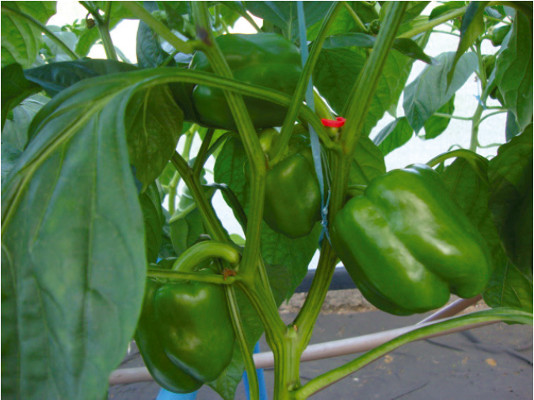Brackish water: an option for producing hydroponic <i>Capsicum annuum</i> in laminar flows of mineral nutrients

Abstract
Sweet pepper plants were grown using a Nutrient Film Technique (NFT) hydroponic system. This study aimed to evaluate the effect of using brackish water on fruit production. The experiment was carried out in a randomized block design with seven treatments and five replications. The electrical conductivity of the water was 0.29, 1.39, 2.75, 4.49, 5.90, 6.76, and 7.09 dS m-1 in the treatments; this water was used for both the nutrient solution preparation and replenishment of crop evapotranspiration. The plant parameters: fruit diameter, fruit length, number of fruits per plant, mean fruit weight, total fruit weight per plant and fruit length/diameter ratio were evaluated 69 days after the transplanting. The use of brackish water with high electric conductivity values did not directly interfere with the sweet pepper production in NFT hydroponic systems, as long as these values did not exceed the sweet pepper salt tolerance of 1.5 to 1.8 dS m-1.
Keywords
Soilless cultivation, semiarid, environmental protection, water reuse.
Author Biography
Adailton Conceição dos Santos
Campus Profª Cinobelina Elvas. Soil Science.
References
- Alves, M.S., T.M. Soares, L.T. Silva, J.P. Fernandes, M.L. Oliveira, and V.P. Paz. 2011. Strategies for use of brackish water in NFT hydroponic lettuce production. Rev. Bras. Eng. Agríc. Ambient. 15, 491-98. Doi: 10.1590/S1415-43662011000500009
- Albuquerque, F.S., E.F.F. Silva, J.A.C. Albuquerque Filho, and M.F.F.N. Nunes. 2011. Growth and yield of sweet pepper fertigated under different irrigation depths and potassium doses. Rev. Bras. Eng. Agríc. Ambient. 15, 686-94. Doi: 10.1590/S1415-43662011000700006
- Albuquerque, F.S., E.F.F. Silva, E. Bezerra Neto, E.R.A. Souza, and A.N. Santos. 2012. Mineral nutrients in fertigated sweet pepper under irrigation depths and potassium doses. Hortic. Bras. 30, 681-87. Doi: 10.1590/S0102-05362012000400019
- Arruda, C.E.M., N.S. Dias, F.F. Blanco, O.N. Sousa Neto, and M. Ferreira Neto. 2011. Bell pepper cultivation with brine from brackish water desalination. Rev. Caatinga. 24, 197-201.
- Ayers, R.S., and D.W. Westcot. 1985. Water quality for agriculture. FAO Irrigation and Drainage, Rome. Benoit, F. 1987. High-technology glasshouse vegetable growing in Belgium. Soilless. Culture. 3, 21-9.
- Cosme, C.R., N.D.S. Dias, A.D. Oliveira, E.M. Oliveira, and O.D. Sousa Neto. 2011. Hydroponic tomato production using reject of desalination in the nutrient solution applied at different stages. Rev. Bras. Eng. Agríc. Ambient. 15, 499-504. Doi: 10.1590/S1415-43662011000500010
- Chartzoulakis, K., and M. Bertaki. 2015. Sustainable water management in agriculture under climate change. Agric. Agric. Sci. Procedia. 4, 88-98. Doi: 10.1016/j.aaspro.2015.03.011
- De Pascale, S., C. Ruggiero, and G. Barbieri. 2000. Effects of irrigating pepper (Capsicum annuum L.) plants with saline water on plant growth, water use efficiency, and marketable yield. Acta. Hortic. 537, 687-95. Doi: 10.17660/ActaHortic.2000.537.81
- Dias, N.D.S., R.B. Lira, R.F. Brito, O.N. Sousa Neto, M. Ferreira Neto, and A.M. Oliveira. 2010. Melon yield in a hydroponic system with wastewater from desalination plant added in the nutrient solution. Rev. Bras. Eng. Agríc. Ambient. 14, 755-61. Doi: 1 10.1590/S1415-43662010000700011
- Ferreira, D.F. 2011. Sisvar: a computer statistical analysis system. Ciênc. Agrotec. 35, 1039-42. Doi: 10.1590/S1413-70542011000600001
- Furlani, P.R., L.C.P. Silveira, D. Bolonhezi, and V. Faquin. 1999. Hydroponic plant cultivation.: IAC, Campinas, Brazil. Kurunc, A., A. Unlukara, and B. Cemek. 2011. Salinity and drought affect yield response of bell pepper similarly. Acta. Agric. Scand. B. 61, 514-22. Doi: 10.1080/09064710.2010.513691
- Leonardo, M., F. Broetto, R.L.V. Boas, R.S. Almeida, and J.A. Marchese. 2007. Production of sweet pepper fruits in different saline concentrations. Irriga. 12, 73-82.
- Maciel, M.P., T.M. Soares, H.R. Gheyi, E.P. Rezende, and G.X. Oliveira. 2012. Production of ornamental sunflower with use of brackish waters in NFT hydroponic system. Rev. Bras. Eng. Agríc. Ambient. 16, 165-72. Doi: 10.1590/S1415-43662012000200006
- Maia, S.S.S., R.C.P. Silva, F.A. Oliveira, O.M.P. Silva, A.C. Silva, and W.S. Candido. 2017. Responses of basil cultivars to irrigation water salinity. Rev. Bras. Eng. Agríc. Ambient. 21, 44-9. Doi: 10.1590/1807-1929/agriambi.v21n1p44-49
- Marschner, P. (ed.). 2012. Marschner’s mineral nutrition of higher plants. Elsevier/Academic Press, London.
- Monteiro, M.T.M., V.F.F. Gomes, P.F. Mendes Filho, and F.V.A. Guimarães. 2009. Absorption of nutrients by seedlings of mycorrhizal pepper cultivated on substrate with coconut powder. Rev. Caatinga 22, 95-101.
- Navarro, J.M., C. Garrido, P. Flores, and V. Martínez. 2010. The effect of salinity on yield and fruit quality of pepper grown in perlite. Span. J. Agric. Res. 8, 142-50. Doi: 10.5424/sjar/2010081-1153
- Paulus, D., D. Dourado Neto, J.A. Frizzone, and T.M. Soares. 2010. Production and physiologic indicators of lettuce grown in hydroponics with saline water. Hortic. Bras. 28, 29-35. Doi: 10.1590/S0102-05362010000100006
- Santos Júnior, J.A., H.R. Gheyi, A.R. Cavalcante, S.D.S. Medeiros, N.D.S. Dias, and D.B.D. Santos. 2015. Water use efficiency of coriander produced in a lowcost hydroponic system. Rev. Bras. Eng. Agríc. Ambient. 19, 1152-58. Doi: 10.1590/1807-1929/agriambi.v19n12p1152-1158
- Sarmento, J.D.A., P.L.D. Morais, M.L.B. Almeida, O.N. Sousa Neto, and N.S. Dias. 2014. Quality and conservation of lettuce grown with desalination waste. Rev. Caatinga 27, 90-7.
- Semiz, G.D., D.L. Suarez, A. Unlukara, and E. Yurtseven. 2014. Interactive effects of salinity and N on pepper (Capsicum Annuum L.) yield, water use efficiency and root zone and drainage salinity. J. Plant. Nutr. 37, 595- 610. Doi: 10.1080/01904167.2013.867985
- Soares, T.M., S.N. Duarte, E.D.F. Silva, and C.A. Jorge. 2010. Combination of fresh and brackish waters for hydroponic lettuce production. Rev. Bras. Eng. Agríc. Ambient. 14, 705-14. Doi: 10.1590/S1415-43662010000700004
- Soares, H.R., E.F.F. Silva, G.F. Silva, E.M.R. Pedrosa, M.M. Rolim, and A.N. Santos. 2015. Lettuce growth and water consumption in NFT hydroponic system using brackish water. Rev. Bras. Eng. Agríc. Ambient. 19, 636- 42. Doi: 10.1590/1807-1929/agriambi.v19n7p636-642
- Soares, T.M. 2007. Use of brackish water in the cultivation of lettuce in hydroponic system NFT as an agricultural alternative, consistent with the Brazilian semi-arid region. Doctoral thesis. Escola Superior de Agricultura “Luiz de Queiroz”, USP, Piracicaba-SP, Brazil.
